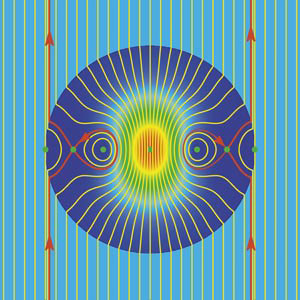| Posted: Jul 13, 2016 |
Invisible particles 'seen' for the first time
(Nanowerk News) A new optical effect in nanoscale disks of silicon, namely patterns of radiation that do not emit or scatter light, has been observed by A*STAR researchers and international collaborators ("Nonradiating anapole modes in dielectric nanoparticles"). These modes, which have never before been observed at visible wavelengths, could be used in tiny lasers that are not much bigger than viruses.
|
 |
| Electromagnetic simulations show that light waves stream almost unperturbed past a silicon nanodisk that has anapole modes. The particle is thus effectively invisible at distances far from the particle. (Image: A*STAR Data Storage Institute)
|
|
A fundamental principle of electromagnetism is that an accelerating electric charge will emit light, losing energy in the process. But, the possibility of creating special configurations of electrical current that do not radiate electromagnetic radiation has intrigued physicists for many decades. Such configurations may serve as possible models of stable atoms, which do not emit radiation despite having orbiting electrons.
|
|
A fascinating example of such a non-radiating source is known as an anapole — a distribution of charges and currents that does not radiate or interact with external electromagnetic fields. Elementary particles that exhibit anapole modes have been proposed as a potential source of the mysterious dark matter, which accounts for about 25 per cent of the mass and energy of the observable Universe, but is invisible to astronomers.
|
|
Now, a team working with Yefeng Yu of A*STAR Data Storage Institute, along with overseas collaborators, have demonstrated the existence of anapole radiation modes in the lab. Specifically, they have created them at visible wavelengths in silicon nanodisks.
|
|
“Our collaborators in Australia and Germany theoretically predicted the existence of anapoles in nanoparticles, and we then confirmed it experimentally,” says Yu. “For such modes, energy does not escape from the nanoparticle through radiation or scattering. And when the nanoparticle is excited by anapole light excitation, it does not scatter the light since it concentrates the energy at close distances and is invisible at long distances.”
|
|
An anapole mode is a combination of two dipole moments — the electric dipole moment and a donut-like one, called a toroidal moment. At large distances from the nanoparticle, these two radiation fields cancel each other out and so appear invisible. The team demonstrated this effect in their experiments by observing that the silicon nanodisks were effectively invisible due to the cancelling of visible light scattering by the nanodisks (see image).
|
|
“Applications of this optical phenomenon have yet to be determined,” says Yu. “At the moment, we think that it could be useful for the design of novel nanolasers.” The team intends to experimentally explore the use of the anapole mode for nanolasers.
|

